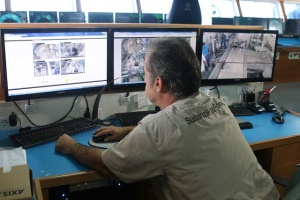Spanish purse seiners want compulsory electronic monitoring on Seychelles-flagged vessels
Fisheries |Author: Salifa Karapetyan Edited by: Betymie Bonnelame | October 20, 2017, Friday @ 10:28| 5733 views
The electronic surveillance cameras were installed on two tuna purse seiners last year. (Joe Laurence)
(Seychelles News Agency) - A Spanish organisation is calling upon the local fishing authority to make electronic monitoring compulsory on all purse seiners fishing in Seychelles’ waters.
The Organisation of Associated Producers of Large Tuna Freezers (OPAGAC) made this request after receiving results from a pilot project that started in 2016. The organisation said that electronic monitoring is “an efficient way of improving tropical tuna fishery management in the Indian Ocean.”
The Seychelles Fishing Authority indicated it would not make such monitoring compulsory at this time.
Last year, the Seychelles Fishing Authority (SFA) in partnership with the Common Oceans ‘Areas Beyond National Jurisdiction’ (ABJN) Tuna Project, OPAGAC and Satlink, a Spanish engineering firm, installed electronic surveillance cameras on two tuna purse seiners.
The main objective was to test the ability of e-monitoring to produce reasonably precise and accurate estimates of retained catch and bycatch on trips by the two Seychelles-flagged vessels.
“This initiative has proved that electronic monitoring systems are able to guarantee high standards of tracking, control and surveillance on the part of coastal states and regional fisheries management organisations,” OPAGAC said in a press statement.
The data collected showed that electronic monitoring systems can provide very high-quality monitoring of the main activities involved in tuna fishing. This includes position tracking, vessel speed recording and identification of vessels’ activities.
The project “is a fundamental initiative for increasing cooperation and joint work by governments, the fishing industry, regional fisheries management organisations and NGOs (non-governmental organisations) with the joint goal of guaranteeing sustainable, ecosystem-friendly fisheries,” said Julio Morón, the general manager of OPAGAC.
He added that such initiatives “are fundamental for continuing to strengthen and harmonise the tracking, control and surveillance systems vital for ensuring true ocean governance.”
An officer from the local Fishing Authority, Vincent Lucas, told SNA that the electronic monitoring will not be compulsory.
“SFA is in favour of human observer and as far as the purse seiners are concerned EMS (electronic monitoring systems) will complement human observers’ work,” said Lucas. He added that this system could, on the other hand, be used for longliners, as logistically it is complicated for them to deploy human observers.
The 115-island archipelago in the western Indian Ocean has been implementing an observer programme onboard its tuna purse seiners fishing since 2012. Following capacity building, the first at sea deployment was initiated in September 2014. Today, Seychelles is assessing the possibility of extending the programme on its industrial longline fishing including the use of Electronic Monitoring System.
The local fishing authority said the pilot project “needs further adjustment in the configuration of the system in order to yield more precise and accurate catch figures.”
Fisheries is the second contributor to the island nation’s economy. Seychelles has a total land area of 455 square kilometres spread over an Exclusive Economic Zone of 1.37 million square kilometres.
Back
